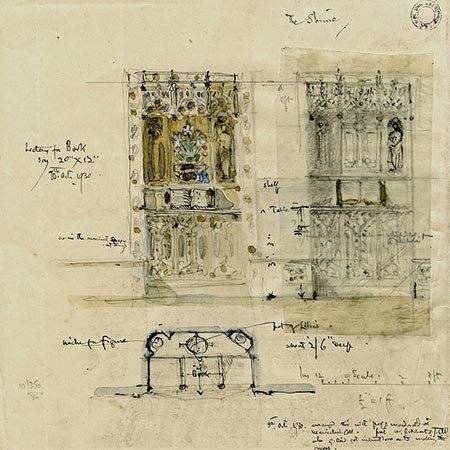
William Kelly (1861 – 1944) is one of Aberdeen’s most distinguished architects, who devoted many years of service to his Alma Mater by his care and attention to the University’s many buildings, particularly his involvement in the restoration of King’s College Chapel and his design of the war memorial situated in the ante-chapel. Kelly’s designs were heavily influenced by the existing medieval carvings situated in the Chapel. He was able to refer to the prize winning drawings of the chapel created by James Cromar Watt (1862 – 1940) which included views of the canopies, stalls and doorway. These drawings and Kelly’s own work on memorials provided the source material and ideas for the final designs.
Kelly designed the memorial to be simple rather than as a sight of grandeur and created a series of oak panels which covered three of the walls in the ante-chapel. On each of the panels the names of the fallen are carved in gilt lettering. In total there are twenty-eight panels which list the 341 University alumni, staff and students who were killed in the Great War. Each panel is framed by leaf and vine motifs which reflect the carvings on the medieval choir stalls in the main chapel. The tops of the panels also have a canopy design which is similar to the medieval stalls. In the cornice there are fifteen medallions showing the coats of arms of the main burghs from the north-east of Scotland from which most lives were lost in the war. There are also two statues on the memorial: Saint Andrew on the West doorway and Saint Michael on the North. The War Memorial took ten years to complete from the initial proposal to the final consecration on Armistice Day 1928.
The niche situated on the South wall was completed after the consecration of the main panels in 1928. The niche was designed to hold a copy of the Roll of Service which could be viewed privately in the style of a small chapter house. Within the niche, either side of the shrine are the bronze figures of ‘mercy’ and ‘peace’.
The memorial’s stained glass window was designed by artist Douglas Strachan (1875 – 1960) and installed around the same time as the niche. Strachan designed the window to symbolise ‘man’s spiritual effort against aggression’. Strachan uses symbolic imagery to represent the elements, the virtues, justice and peace, which battle against ‘the evil presence’ which is symbolised as a dragon. A group of modern soldiers are depicted sending out the final “cease fire” bugle call. Strachan uses a central dominating cross as the symbol of religious belief which is surrounded by the symbols for passion, self-sacrifice, faith, hope and love.
Kelly and Strachan’s designs united within the ante-chapel create a peaceful space for reflection and remembrance for those who died in World War One.
Further information about William Kelly and the war memorial can be found in the World War One Resources Factsheet.
